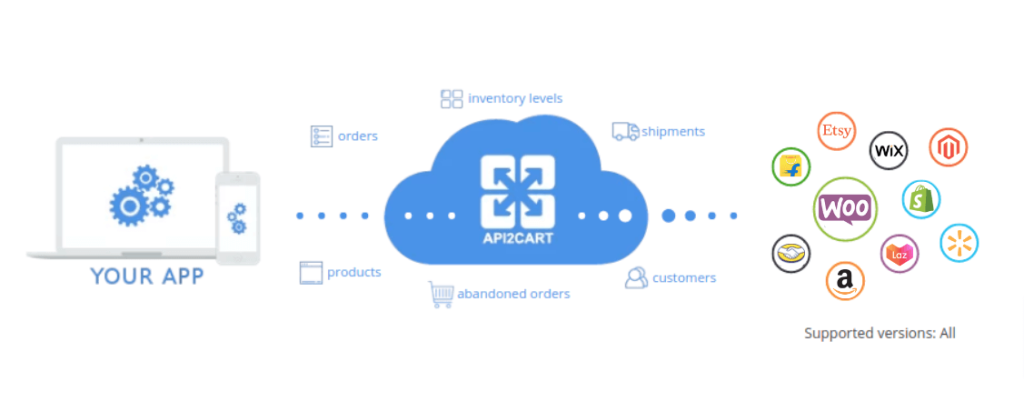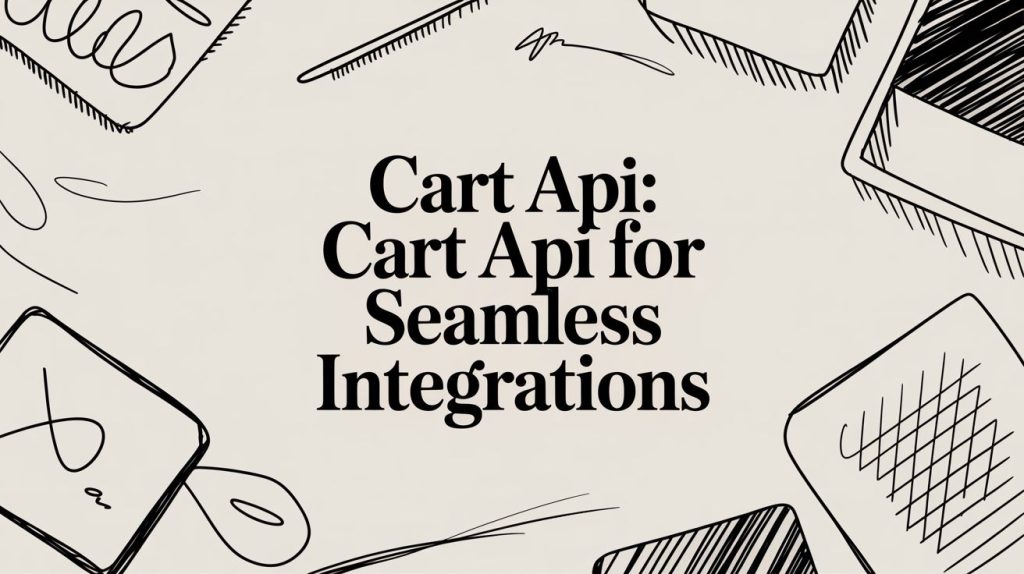
In the world of eCommerce, it is common to connect two APIs together to enable smooth business operations and a quality customer experience. APIs, short for Application Programming Interfaces, are ways by which two or more software systems can interact to exchange data.
For eCommerce software vendors, this means integrating APIs of various eCommerce platforms such as Shopify, WooCommerce, BigCommerce, etc. Connecting two APIs together can unlock significant operational efficiencies, reduce manual tasks, and provide a unified platform for managing diverse eCommerce functions.
This article will illuminate the significance of APIs in eCommerce, the difficulties of integrating with them, and the important guidelines for effectively connecting two APIs to get the most out of your eCommerce solutions.
The Importance of APIs in eCommerce
While APIs are used in many spheres outside the e-market, their employment in eCommerce is on the rise. They may shorten the time to market for a new product or service and incorporate new market channels.
APIs and the opportunities that come with them are highly sought after as they have never been before. An API is a technique that SaaS applications use to integrate with other applications and through which most SaaS applications obtain and modify their data.
There are many reasons why SaaS vendors should provide APIs, as well as why their consumers need them. APIs are a way for channel partners and integrators to be able to link a set of applications and deliver a solution to their clients. Thus, APIs help channel partners with their tasks and, at the same time, reduce the cost of customer acquisition for SaaS providers. APIs also allow clients to export data if they wish to shift from one provider to the next.
SaaS that has applications built on API has many benefits, among others. It allows users to interact with the applications through the UI, and other applications can communicate with the underlying one through the API.

Common Pitfalls of eCommerce API Connection
Connecting with APIs may become the cornerstone of a system's functioning or an additional enhancement that expands the product and attracts customers.
To the B2B software providers targeting e-retailers, it is imperative to create integration between their system's API and shopping cart API. Their clients are involved with e-retailers and require data from their stores to be extracted and analyzed using their software. It is impossible to get the essential data on orders, customers, products, shipments, etc., without linking to the shopping cart applications that e-sellers use to run their stores.

When developing a shopping cart API integration on your own, consider the following issues:
Cost
The integration with each of the eCommerce platforms can take weeks and cost thousands of dollars. Every integration costs a lot, and the numbers can quickly accumulate if several integrations are necessary.
Time
One integration usually takes a month to finish. When several integrations are needed, it means that they all have to be developed and tested properly, and this may take some time. Potential clients may be lost since they cannot afford to wait.
Version Updates
Other challenges include shopping platforms' APIs always updating to new versions, and this may lead to wrong information or data retrieval problems. There will be a need to update the code frequently to be compatible with the new and latest versions.
API Documentation Challenges
Most of the eCommerce platforms as well as marketplaces, have poor APIs. For instance, the API of Amazon is rather old and does not have very clear documentation that may miss critical data. The integration with Magento's API is difficult because the documentation is inaccurate; the documentation of Etsy's API is also problematic as it is difficult to locate, which takes additional time and effort to search for.
Developer Expertise
This means that developing a connection with the shopping cart API requires the services of very experienced developers who have done a similar integration before. These developers are rather scarce because the integration process itself is rather complicated from a technical standpoint.
Security Risks
Manual integration development is a threatening process that can damage your software. Poor integration can leave your system open to attack from criminals who intend to acquire data. It is important that you take all the necessary precautions to protect your system and data.
Examples of Connecting Two APIs Together in eCommerce
The eCommerce business is highly interconnected and interdependent, particularly for B2B services that heavily rely on shopping carts. Running such businesses in isolation is rarely effective, as they require access to customer, order, product, and other actionable data to operate their core processes. To seamlessly retrieve and manipulate this data, applications must connect their API with shopping cart APIs where the information is stored. The optimal way to establish a continuous data interchange between two different systems is through integration.
B2B software solutions that need API integration with eCommerce platforms are numerous. Here are some types of businesses that have proven to benefit from connection with multiple shopping platforms APIs:

1. Marketing Automation Software
Marketing automation tools are dependent on shopping platforms since their key activities involve using product and order information, customer details, coupons, and any other data held in the store's database.
2. Repricing Software
Such types of software need price and product data from online stores to provide their functionality. This is only possible if they connect two APIs together efficiently (their systems API and shopping cart API).
3. Inventory, Order, and Warehouse Management Systems
Such systems need to have access to the e-store databases to get the information on the products, categories, customers, orders, as well as tracking numbers.
4. Dropshipping Automation Software
Dropshipping API integration with the shopping platforms enables such systems to get and synchronize the order, customer, and product data collected from the different online stores.
5. Shipping Management Software
Shipping software need to connect their API with eCommerce APIs together in order to efficiently import orders from different sales channels, update transport info and order statuses, create shipping labels, and compile data into detailed reports.
6. Cart Abandonment Solutions
These tools need to be connected with eCommerce APIs which provide information on the abandoned cart; this allows the tool to immediately send out a reminder or offer to the customer in a bid to recover the sale. As a result of integration with shopping carts these solutions can track user actions, collect information about the abandoned carts and initiate automated marketing actions to address the customers and complete the purchase.
Therefore, B2B software providers need to connect with shopping carts APIs to gain the necessary data that is vital in the performance of their tasks. From marketing automation, mobile application development, repricing, inventory management, chatbots, dropshipping automation, and shipping management, shopping carts ensure that these solutions work to their optimum, thus offering immense value to the users.
That is why, from the very developing stage, vendors create API strategies and plan on the platforms they need to integrate their systems with. The more connections a vendor establishes, the more opportunities to expand his market share he gets.

Solution to Connect Two APIs Together Efficiently
As you know now about the significance of connecting together your software API with the shopping cart API, it is time to introduce the best solution for your B2B SaaS business. Considering the difficulties and the need to integrate with all your clients' eCommerce stores, you need a unified solution to connect your eCommerce software with different shopping platforms.
API2Cart is what you need. It is a unified shopping cart integration API which enables your software to connect with over 40 eCommerce platforms at a go. This all-inclusive solution enables your eCommerce software to integrate with all the shopping carts and marketplaces at once.

API2Cart allows adding, deleting, updating, and modifying data for all the client stores without any difficulty. We offer over 100 API methods to manage store data, such as orders, products, customers, shipments, and categories.
API2Cart makes it easy for your software to decrease TCO, minimize time and money input, and decrease the time and resources spent on integration support. Above all, you can take advantage of our trial offer and use our service for 14 days for free.
Conclusion
An ability to effectively connect two APIs together in an eCommerce landscape can greatly improve the performance of various business systems and processes. Thus, it is crucial to understand the purpose of the integration, prepare for it, take the next steps, and maintain the connection using a third-party integration solution to achieve the best results and get the maximum value.



